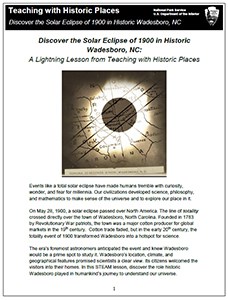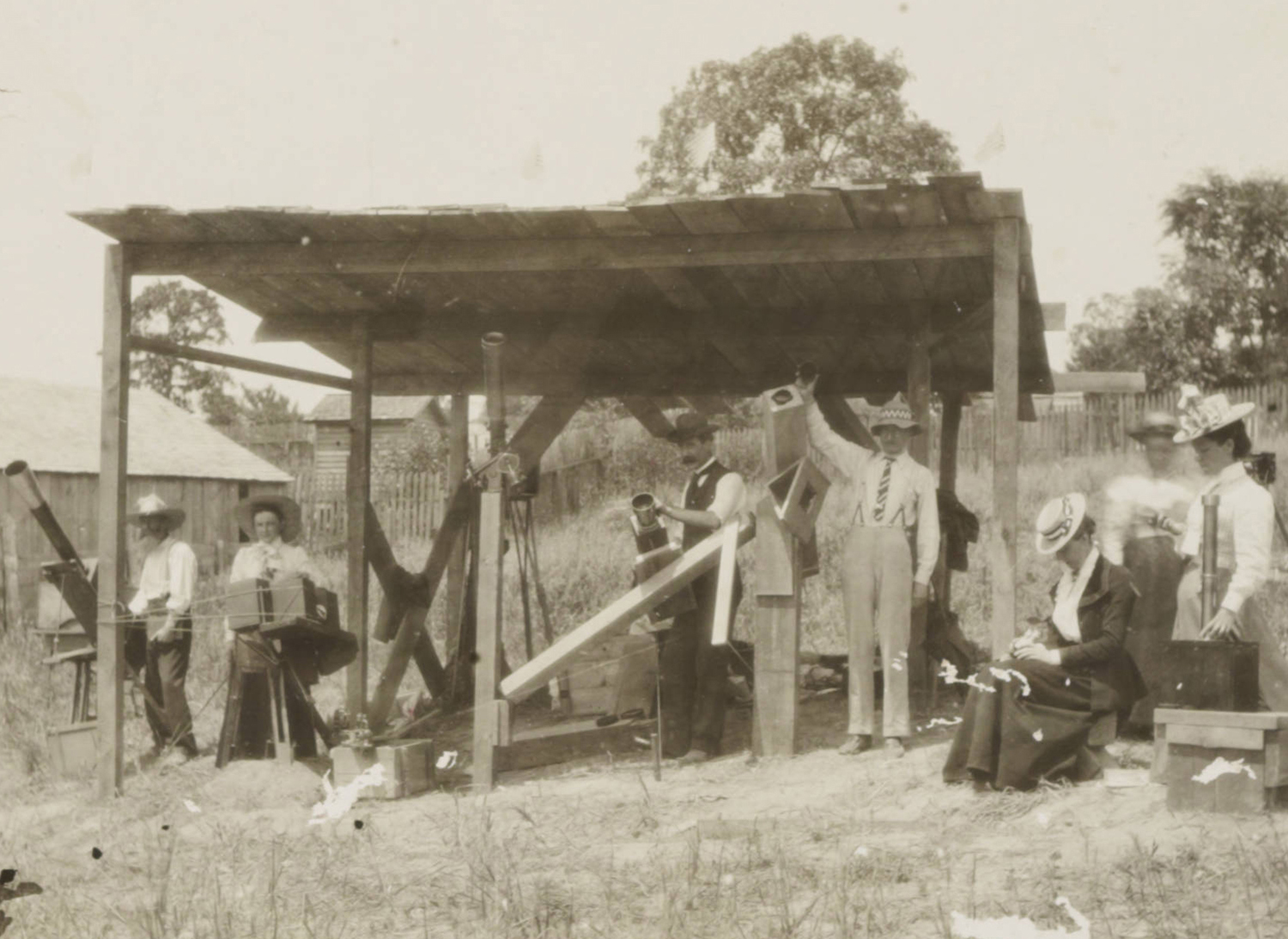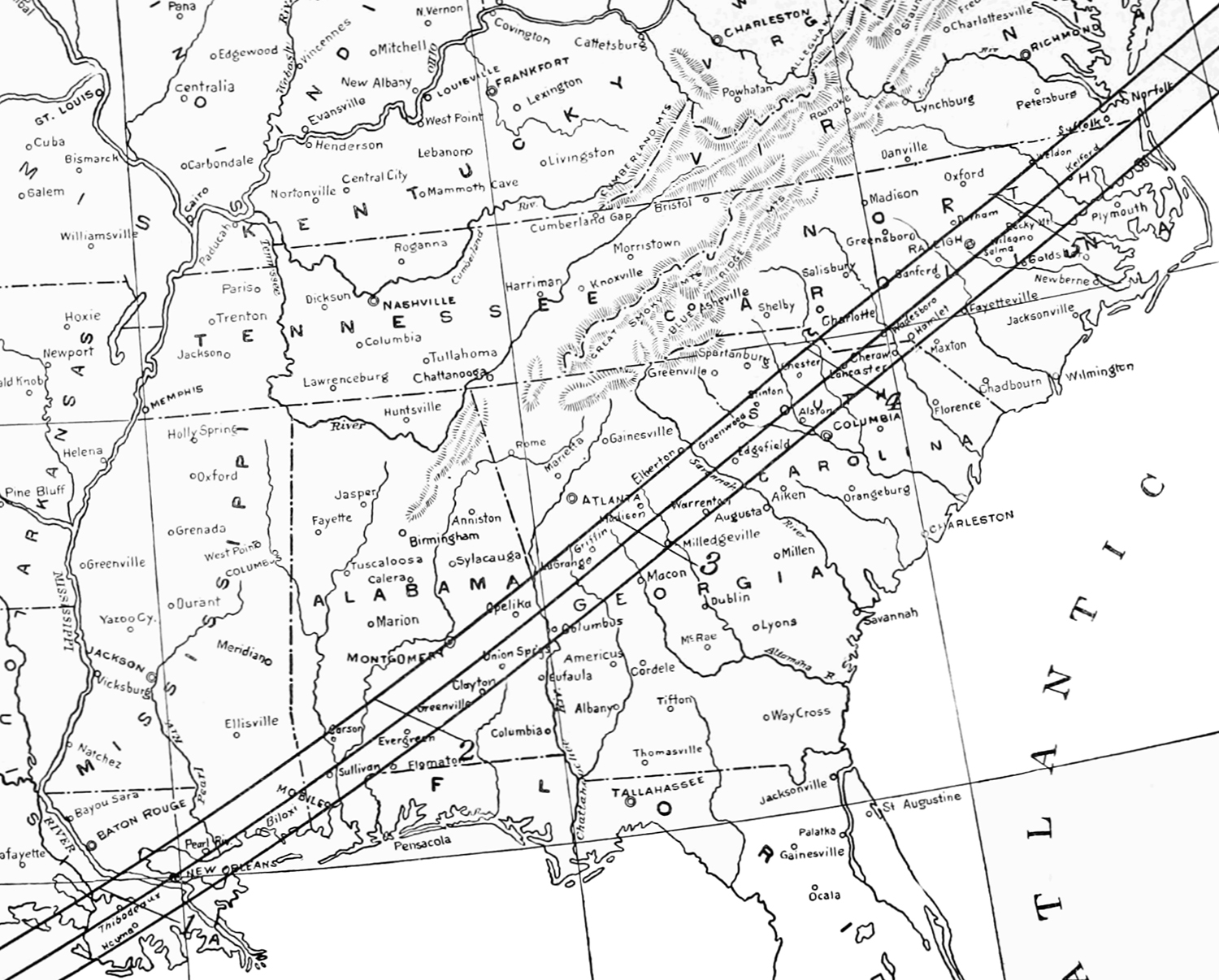
Contents
| Introduction
| Materials in the Lesson (Maps, Readings, Visual Evidence)
| Post-Lesson Activities
| Where it Fits Into the Curriculum (Objectives and Standards)
| More Resources
| About
What historic place might you study to answer this question? Why?
Events like a total solar eclipse have made humans tremble with curiosity, wonder, and fear for millennia. Our civilizations developed science, philosophy, and mathematics to make sense of the universe and to explore our place in it.
On May 28, 1900, a solar eclipse passed over North America. The line of totality crossed directly over the town of Wadesboro, North Carolina. Founded in 1783 by Revolutionary War patriots, the town was a major cotton producer for global markets in the 19th century. Cotton trade faded, but in the early 20th century, the totality event of 1900 transformed Wadesboro into a hotspot for science.
The era’s foremost astronomers anticipated the event and knew Wadesboro would be a prime spot to study it. Wadesboro’s location, climate, and geographical features promised scientists a clear view. Its citizens welcomed the visitors into their homes. In this STEAM lesson, discover the role historic Wadesboro played in humankind’s journey to understand our universe.
Materials Found in the Full Lesson
Accompanying Question Sets are paired with all materials in the Full Lesson (PDF).
Map 1: Path of Totality during the May 28, 1900 Solar Eclipse," a primary source document from The Popular Science Monthly magazine, Vol. 57, published in 1900.
• Text: Primary and secondary source readings provide content and spark critical analysis.
Reading 1: Report on the Relations between Smithsonian Visitors and the Townspeople of Wadesboro, a secondary source reading by the National Park Service.
Reading 2: Report on the Relations between Smithsonian Visitors and the Townspeople of Wadesboro, a primary source reading written by American scientific leaders Samuel Langley and Charles Abbot, 1904 (government document).
Photo 1: British Astronomical Association with their equipment in Wadesboro, NC (Wilson Special Collections Library).
| Photo 1: British Astronomical Association with their equipment in Wadesboro, NC. | Map 1: Path of Totality during the May 28, 1900 Solar Eclipse |
 |
 |
• Activity 1: Charting Solar Eclipses around the World.
• Activity 2: Lights, Camera, Action: A Solar Eclipse in Motion.
• Activity 3: Get involved! Light Pollution and Night Skies in Your Community.
Where it Fits into the Curriculum
This lesson could be used in middle and high school units relating to topics of astronomy, geography, citizen science, and the history of modern science.
Time Period: Early 20th century
Objectives for students
1. To explain what a solar eclipse is and describe ways humans experience the event;
2. To identify Wadesboro, North Carolina's location on map and explain why scientists chose it as a place to study the total solar eclipse of 1900.
3. To demonstrate their understanding of one of three topics covered in an optional activity: Total Solar Eclipses around the world and the importance of a global perspective; The movement of the Moon’s shadow on the Earth during a solar eclipse done through role-play; Light pollution in your community and the value of dark skies.
National Standards for Science, Social Studies, and Common Core
This lesson relates to Thematic Strands from the National Council for the Social Studies' National Standards:
• Theme III: People, Places, Environments; Standards A, C, G-I
• Theme V: Individuals, Groups, & Institutions; Standards B, F,
• Theme VIII: Science, Technology, & Society; Standards A-C
• Theme IX: Global Connections
• CCCSS.ELA-Literacy.RH.6-12.1
• CCSS.ELA-Literacy.RH.6-12.2
Craft and Structure
• CCSS.ELA-Literacy.RH.6-12.5
• CCSS.ELA-Literacy.RH.6-12.6
Integration of Knowledge and Ideas
• CCSS.ELA-Literacy.RH.6-12.7
See the Full Lesson (PDF) for details about how the these Standards and Themes relate to the lesson. Search our Lesson Plans by National History Standards or Lesson Plans by Social Studies Standards to identify lessons that correspond with the eras and themes you want to teach.
The National Park Service "Natural Phenomena" website includes in-depth coverage of eclipses, where visitors can find photographs and maps of different types of eclipses, eye safety tips, and information about past and future eclipses. The site includes an interactive map showing the National Parks and park events along the path of totality during the August 2017 solar eclipse.
National Aeronautics and Space Administration (NASA)
NASA offers a webhub to explore solar eclipses, lunar eclipses, and other movements of planetary objects online, hosted under the main NASA Eclipse Web Site. This place also offers information about the 2017 eclipse, eye safety, and predictions for when a total solar eclipse will occur in specific areas.
NASA explains equinoxes, solstices, full moons, and eclipses on their website “NASA Satellites Ready When Stars and Planets Align.”
Town of Wadesboro
The Anson County government website offers information about the Downtown Wadesboro Historic District. It contains historical and contemporary photographs of town buildings and landscapes.
Google Sky
The Google Sky resource compiles data from observatories around the world to provide an interactive website to view real-time locations of planets, constellations, galaxies, and nebulae. It offers views of the universe in x-ray, ultraviolet, and infrared as well as publishes podcasts on upcoming astronomical events.
American Astronomical Society
The American Astronomical Society offers educational materials with links to online courses, lesson plans, and videos about lunar and solar eclipses. The AAS also provides a resource on preparing for the Eclipse and safely observing the Sun.
This lesson plan is based on the National Register for Historic Places nominations for the Wadesboro Downtown Historic District and the Boggan-Hammond House and Alexander Little Wing. Discover the Solar Eclipse of 1900 in Historic Wadesboro, NC: A Lightning Lesson from Teaching with Historic Places was published in 2017. This lesson was written by National Park Service contractors, Beth Pruitt and Maria A. Lee Strohmayer. It was edited by National Park Service historian Katie Orr and the Cultural Resources Office of Interpretation and Education staff in Washington, D.C. This lesson is one in a series that brings the important stories of historic places into classrooms across the country.
Last updated: September 26, 2024
